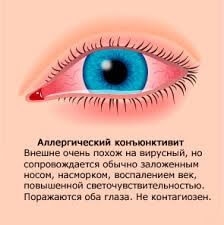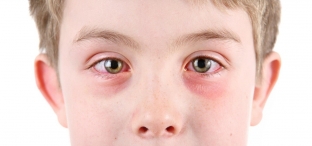Allergic conjunctivitis is a widespread disease that occurs in almost all countries of the world, affecting up to 20% of people of young working age. Sometimes the symptoms of allergic conjunctivitis are so pronounced that they interfere with work and lead to sleep disturbance. In most cases, the symptoms of allergic conjunctivitis are closely related to bronchial asthma, allergic rhinitis and atopic dermatitis. Often, allergic conjunctivitis is accompanied by damage to other parts of the eyes. Read more about the symptoms of allergic conjunctivitis on estet-portal.com.
What are the forms of allergic conjunctivitis?
Allergic conjunctivitis is a disease based on an allergic reaction, accompanied by inflammation in the conjunctiva of the eyes in response to the action of the environment.
 Frequent clinical manifestations and symptoms of allergic conjunctivitis are lacrimation, conjunctival hyperemia, itching, swelling of the eyelids, foreign body sensation and photophobia.
Frequent clinical manifestations and symptoms of allergic conjunctivitis are lacrimation, conjunctival hyperemia, itching, swelling of the eyelids, foreign body sensation and photophobia.
Several factors and causes can provoke the symptoms of allergic conjunctivitis. Based on the causes, allergic conjunctivitis is divided into several forms.
Forms of allergic conjunctivitis:
- seasonal allergic conjunctivitis in patients with hay fever;
- year-round;
- medicinal;
- contact.
Symptoms of seasonal allergic conjunctivitis
Seasonal allergic conjunctivitis is quite rarely the only manifestation of pollinosis and is caused by sensitization to allergens of spore-forming fungi or pollen of wind-pollinated plants. Patients have a combination of nasal and ocular symptoms – rhinoconjunctivitis. Moreover, in most patients, eye symptoms are more severe than nasal ones.
Symptoms of seasonal allergic conjunctivitis first appear between the ages of 10 and 40, more often in females. Residents of the city get sick many times more often than residents of the village, notes estet-portal.com. Symptoms of allergic conjunctivitis are provoked by the pollen of trees, weeds and cereals.
The developmental mechanism is a classic example of immediate IgE – due to an allergic reaction. Mast cells of the conjunctiva play a huge role in the development of symptoms of allergic conjunctivitis. Like cells – targets they are the source of the entire spectrum of allergy mediators. The number of mast cells in the eye tissues is about 50 million. The main symptoms of seasonal allergic conjunctivitis – itching, hyperemia, swelling and lacrimation.

Symptoms of year-round allergic conjunctivitis
In most cases, the symptoms of allergic conjunctivitis of the year-round form appear against the background of sensitization by aeroallergens of residential premises. These are allergens from house dust mites, allergens from insects and pets.
The house dust mite is the most active allergen and the main cause of most allergic diseases.
The symptoms of allergic conjunctivitis of the year-round form are characterized by a subacute course with a mild clinical picture, which is combined with symptoms of other allergic diseases. There is moderate burning of the eyes, intermittent itching of the eyelids and slight discharge from the eyes.
Symptoms of allergic conjunctivitis dosage form
The frequency of this form of allergic conjunctivitis has been steadily increasing in recent years. Symptoms of allergic conjunctivitis occur sharply and acutely with repeated medication, but with a long course of treatment, the incidence of an allergic reaction is low. In most cases, the disease is caused by preservatives contained in eye drops.
Acute reaction appears for 20 – 60 minutes, a delayed reaction develops within a day, a delayed reaction can occur for several weeks. Cases of the development of symptoms of allergic conjunctivitis are described against the background of long-term use of atropine-containing eye drops. This form is characterized by such symptoms of allergic conjunctivitis: swelling and swelling of the eyelids, itching and severe lacrimation, hemorrhages are possible.
Symptoms of allergic conjunctivitis contact form
Symptoms of contact form allergic conjunctivitis appear when the conjunctiva or eyelid comes into direct contact with what – or an allergen, resulting in an inflammatory reaction. At the same time, contact dermatitis always develops on the skin of the eyelid. Contact conjunctivitis is characterized by a long course and combination with damage to other parts of the eyes (keratitis, blepharitis, eyelid dermatitis).
A separate place is occupied by allergic conjunctivitis when wearing contact lenses. It is believed that 55% of people who wear contact lenses will sooner or later develop symptoms of allergic conjunctivitis on the contact lens material. With the development of conjunctivitis on the eyelids, you can find papillae of different sizes, hyperemia of the mucous membrane, point erosion of the cornea and edema.
If symptoms of allergic conjunctivitis are detected, you should contact an allergist and an ophthalmologist to identify the cause of the disease and to eliminate it.







Add a comment